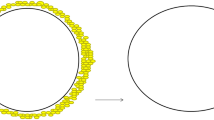Abstract
Background
Throughout the years the female breast has been manipulated through aesthetic and reconstructive surgery. Since the 18th century there have been reports of techniques that have tried to increase the volume of the mammary gland. This article demonstrates a technique for increasing the volume of the mammary gland by dissection of the fascia of the pectoralis major muscle. This technique provides long-term results due to the optimized dynamics between the soft tissue and the implant. The subfascial technique is paramount to the subglandular method because primarily it offers better palpable firmness in the periareolar area, a significant decrease in the step effect produced by an excessive projection of the breast, a favorable gravitational pull of the breast, and a considerable reduction in the incidence of capsular contractures. The movement of the implant, postsurgical pain, and bleeding caused by the incision of the pectoralis muscle diminish with this technique. Because of the fascia’s tendency to be preserved, this procedure has the advantage of being able to be applied where previous surgery has been performed; this concedes the subfascial technique a more versatile angle.
Methods
In the last 10 years 1000 patients were subjected to subfascial breast augmentation with soft-gel cohesive textured implants. An inframammary incision was used in 95% of the patients and the periareolar incision in 5%.
Results
The patient does not suffer from immediate postsurgical pain. Recovery time and the ability to start daily activities is briefer than after the submuscular procedure. A better projection is obtained without the need to use a bigger implant to get the same result because there is no pressure on top of the implant as in the submuscular technique.
Conclusion
The subfascial procedure offers a high-grade result for the short and long term and has fewer disadvantages than the submuscular or subglandular technique. Likewise, there are fewer immediate postoperative symptoms and patients have a much better and less painful recovery. The morbidity in these patients is less than with the subglandular and submuscular methods.






Similar content being viewed by others
References
Barnett A (1990) Transaxillary subpectoral augmentation in the ptotic breast: augmentation by disruption of the extended pectoral fascia and parenchymal sweep. Plast Reconstr Surg 86(1):76–83
Didie ER, Sarwer DB (2003) Factors that influence the decision to undergo cosmetic breast augmentation surgery. J Womens Health 12(3):241–253
Sarwer DB, LaRossa D, Bartlett SP, Low DW (2003) Body image concerns of breast augmentation patients. Plast Reconstr Surg 112(1):83–90
Benito-Ruiz J (2003) Transaxillary subfascial breast augmentation. Aesthet Surg J 3:480
Benito-Ruiz J (2004) Subfascial breast implant. Plast Reconstr Surg 113:1088
Benito-Ruiz J (2005) Aumento mamario trasaxilar subfascial/subglandular. Cir Plast Iberlatinamer 31:47
Goes JC, Landecker A (2003) Optimizing outcomes in breast augmentation: seven years of experience with the subfascial plane. Aesthetic Plast Surg 27(3):178–184
Graf RM, Bernardes A, Rippel R, Araujo LR (2003) Subfascial breast implant: a new procedure. Plast Reconstr Surg 111(2):904–908
Graf RM, Bernardes A, Auersvald A, Damasio RC (2000) Subfascial endoscopic transaxillary augmentation mammaplasty. Aesthetic Plast Surg 24(3):216–220
Ventura OD, Marcello G, Gamboa C, Miro A (2006) Implantes mamarios en el plano subfascial en reemplazo del bolsillo subglandular: un cambio lógico. Cir Plast Iberlatinamer 32(1):11–16
Ruot-Worley J (2001) Augmentation mammaplasty: implications for the primary care provider. J Am Acad Nurse Pract 13(7):304–309
Achauer B, Eriksson E, Guyuron B (2000) Plastic Surgery, vol 5. Mosby, St. Louis
Coiffman F (1994) Cirugía Plástica, Reconstructiva y Estética, 2ª ed, Tomo IV. Masson-Salvat, Barcelona
Author information
Authors and Affiliations
Corresponding author
Rights and permissions
About this article
Cite this article
Tijerina, V.N.E., Saenz, R.A.E. & Garcia-Guerrero, J. Experience of 1000 Cases on Subfascial Breast Augmentation. Aesth Plast Surg 34, 16–22 (2010). https://doi.org/10.1007/s00266-009-9402-4
Received:
Accepted:
Published:
Issue Date:
DOI: https://doi.org/10.1007/s00266-009-9402-4




